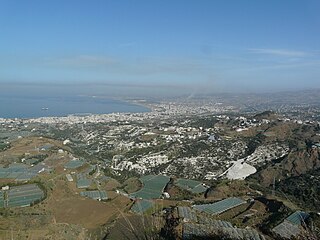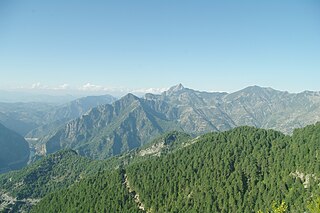External links
![]()
Euroea in Phoenicia was a city in the late Roman province of Phoenicia Secunda. [1] today Hawarin, north of al-Qaryatayn and on the road from Damascus to Palmyra. There are ruins of a Roman castellum and of a basilica.
The true name of this city seems to have been Hawârin; as such it appears in a Syriac inscription of the fourth to the sixth century. According to Ptolemy [2] it was situated in the Palmyrene province. Georgius Cyprius calls it Euarios or Justinianopolis.
The Notitiae episcopatuum of the Patriarchate of Antioch (6th century) gives Euroea as a suffragan see of the archdiocese of Damascus. [3] One of its bishops, Thomas, is known in 451; there is some uncertainty about another, John, who lived a little later. [4]
Euroea is included in the Catholic Church's list of titular sees. [5] Until 1935 it was called Evaria (Euaria, Euroea). [6]
![]()

Phaselis was a Greek and Roman city on the coast of ancient Lycia. Its ruins are located north of the modern town Tekirova in the Kemer district of Antalya Province in Turkey. It lies between the Bey Mountains and the forests of Olympos National Park, 16 kilometres (9.9 mi) south of the tourist town of Kemer and on the 57th kilometre of the Antalya–Kumluca highway. Phaselis and other ancient towns around the shore can also be accessed from the sea by daily yacht tours.

Ptolemais was one of the five cities that formed the Pentapolis of Cyrenaica, the others being Cyrene, Euesperides, Tauchira/Teuchira, and Apollonia.

Abila Lysaniou or Abila Lysaniae or Abila was an ancient city, on the Abana River and capital of ancient Abilene, Coele-Syria. The site is currently that of the village of Souq Wadi Barada, circa 20 km (12 mi) northwest of Damascus, Syria. It has also been identified as the village of Abil just south of Homs in central Syria. The city's surname is derived from Lysanias, a governor of the region.
Araxa was a city of ancient Lycia, according to Alexander Polyhistor, in the second book of his Lysiaca. Ptolemy places it near Sidyma. It is located at place called Ören, near Fethiye, on the upper portion of the Xanthus River. An inscription in honour of a local citizen, Orthagoras, provides some details of its history in the 2nd century B.C.
Danaba was a town and bishopric in the late Roman province of Phoenicia Secunda.

Nicopolis was a Roman colony in Lesser Armenia founded by Pompey in 63 BC after conquering the Kingdom of Pontus in the third Mithridatic War. It became part of the Roman province of Armenia Prima. Today, the city of Koyulhisar in northeastern Turkey occupies the site.
Polybotus or Polybotos was a city in the Roman province of Phrygia Salutaris. The city's bishop was a suffragan of Synnada, and later of Amorium. Its site is located 3 miles (4.8 km) southwest of Bolvadin in Asiatic Turkey.
Porphyreon was a town in the late Roman province of Phoenice Prima, and a bishopric that was a suffragan of the metropolitan see of that province, Tyre. It corresponds to present-day Jieh, Lebanon.
Caloe was a town in the Roman province of Asia. It is mentioned as Kaloe or Keloue in 3rd-century inscriptions, as Kalose in Hierocles's Synecdemos (660), and as Kalloe, Kaloe, and Kolone in Parthey's Notitiæ episcopatuum, in which it figures from the 6th to the 12fth or 13th century.
Cestrus was a city in the Roman province of Isauria, in Asia Minor. Its placing within Isauria is given by Hierocles, Georgius Cyprius, and Parthey's. While recognizing what the ancient sources said, Le Quien supposed that the town, whose site has not been identified, took its name from the River Cestros and was thus in Pamphylia. Following Lequien's hypothesis, the 19th-century annual publication Gerarchia cattolica identified the town with "Ak-Sou", which Sophrone Pétridès called an odd mistake, since this is the name of the River Cestros, not of a city.
Euroea or Euroia was a city in Epirus, in western Greece, during late antiquity. It was abandoned in the early 7th century due to Slavic invasions. During the 4th–8th centuries, it was a bishopric. Since the 18th century, it is also a titular see of the Catholic Church.
Eudoxias was a city and bishopric in the late Roman province of Galatia Secunda, in Asia Minor.
Temnos or Temnus was a small Greek polis (city-state) of ancient Aeolis, later incorporated in the Roman province of Asia, on the western coast of Anatolia. Its bishopric was a suffragan of Ephesus, the capital and metropolitan see of the province, and is included in the Catholic Church's list of titular sees.
Trapezopolis or Trapezoupolis (Τραπεζούπολις) was a city of ancient Caria, and later in the late Roman province of Phrygia Pacatiana Prima.

Baniyas is a city in Tartous Governorate, northwestern Syria, located 55 km (34 mi) south of Latakia and 35 km (22 mi) north of Tartous.

Irenopolis or Eirenopolis was an ancient Roman, Byzantine and medieval city in northeastern Cilicia, not far from the Calycadnus river, also known briefly as Neronias in honour of the Roman emperor Nero. Irenopolis was also an episcopal see that is now included in the Catholic Church's list of titular sees.

Huwwarin is a village in central Syria, administratively part of the Homs Governorate, south of Homs. Situated in the Syrian Desert, the village is adjacent to the larger town of Mahin to its south and lies between the towns of Sadad to the west and al-Qaryatayn to the east. Its inhabitants are predominantly Muslims.
The Metropolis of Corinth, Sicyon, Zemenon, Tarsos and Polyphengos is a metropolitan see of the Church of Greece in Corinthia, Greece. Since the Middle Ages it has also existed as a Roman Catholic titular see. The current metropolitan is Dionysios Mantalos.
Acarassus or Akarassos was a city in ancient Lycia.
Carallia was a city of the Roman province of Pamphylia Prima and is mentioned in the acts of the Council of Ephesus (431). The same form of the name is given in the acts of the Council of Chalcedon (451).